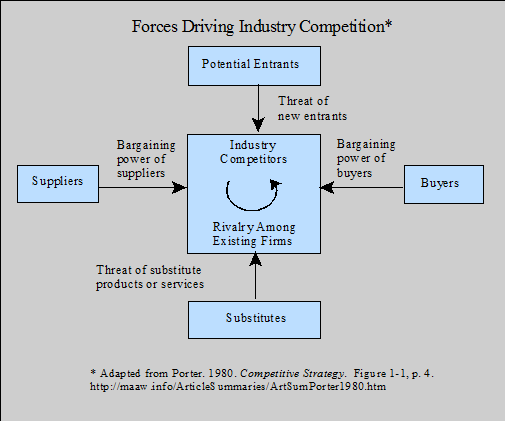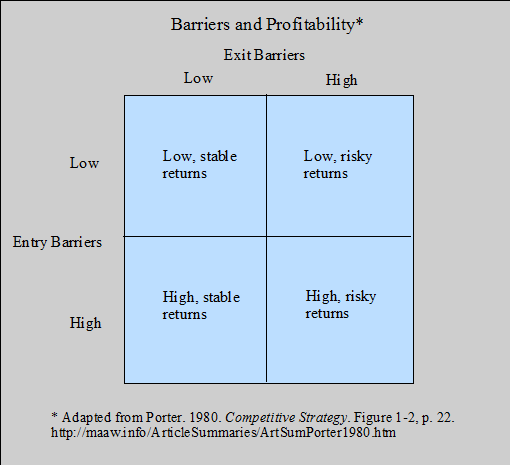
Chapter 1: The Structural Analysis of Industries
Study Guide by James R. Martin, Ph.D., CMA
Professor Emeritus, University of South Florida
Porter's Competitive Strategy Summaries Main Page
Chapter 1: The Structural Analysis of Industries p. 3
This chapter is focused on the five basic competitive forces that determine the economic structure of the industry in which the firm competes. As illustrated in the graphic below, these include the threat of new entrants, the threat of substitute products or services, the bargaining power of buyers, the bargaining power of suppliers, and the rivalry among current competitors. The goal of a firm's competitive strategy is to find a place within the industry where it can defend itself from these forces and successfully compete.

Structural Determinants of the Intensity of Competition p. 5
An industry is defined as a group of firms producing products or services that are close substitutes for each other. The illustration above shows that competition in an industry includes many other groups and factors in addition to the established players, i.e., potential entrants, customers, suppliers, and substitute products and services. All of these forces determine the intensity of competition in an industry.
Threat of Entry p. 7
The threat of entry depends on barriers to entry and reactions from current competitors.
Barriers to entry include six types:
1. Economies of scale - The benefits of economies of scale can be obtained from large scale operations, multiple business units where joint products and by-products are involved, and through vertical integration.
2. Product differentiation - Product differentiation refers to where a firm has brand identification and customer loyalties obtained from advertising and customer service.
3. Capital requirements - Capital requirements are a barrier in many industries where large investments are required for production facilities, inventory, and research and development.
4. Switching costs - Switching costs refers to the buyer's costs of switching from one product to another.
5. Access to distribution channels - Access to distribution channels refers mainly to wholesale and retail channels for a product.
6. Government policy - Various government policies such as licensing requirements, and regulations (e.g., pollution control, product testing) can present barriers to entry.
In addition there are cost disadvantages independent of scale. For example, some firms have proprietary product technology, or more favorable access to raw materials.
Reactions from current competitors might include pricing products at or below what Porter refers to as the entry deterring price.
Experience, i.e., the experience curve, can also provide a barrier, but it tends to be weaker than the six types of barriers to entry mentioned above.
Intensity of Rivalry Among Existing Competitors p. 17
Rivalry among competitors takes the form of price competition, advertising battles, product introductions, and increased customer service or warranties. Price wars tend to be detrimental to an industry. Advertising battles may increase demand or enhance the level of product differentiation in an industry.
Intensity of rivalry is influenced by a number of interacting structural factors including:
1. When there are numerous or equally balanced competitors,
2. slow industry growth,
3. high fixed or storage costs in the industry,
4. a lack of differentiation or switching costs,
5. situations where capacity must be added in large increments (resulting in overcapacity and price cutting),
6. diverse competitors with differing strategic choices,
7. where strategy for some firms is based on achieving global prestige or technical credibility, and
8. where there are high exit barriers caused by the requirement for specialized assets, high fixed costs to exit, strategic interrelationships, emotional barriers and government and social restrictions.
Many of these factors can change. Some examples include, where industry growth slows down as an industry approaches maturity, and where changes in technology increases the level of fixed cost required.
Entry and exit barriers work together to affect the returns in an industry as illustrated in the simple case below where both entry and exit barriers are either high or low.

Pressure From Substitute Products p. 23
Substitute products are other products that can perform the same function as the product of the industry and limit returns in an industry by limiting prices. For example, substitute products for securities brokers include real estate and money market funds. Products that are improving in terms of price vs. performance, and those that are produced by high profit industries deserve the most attention for analysis.
Bargaining Power of Buyers p. 24
A buyer group's bargaining power is enhanced when the following characteristics exist in an industry:
1. A buyer group is concentrated, or purchases relatively large volumes in terms of the seller's total sales,
2. the products purchased by a buyer group represent a large percentage of the buyer's costs,
3. the products purchased by a buyer group are standard or undifferentiated,
4. a buyer group faces switching costs,
5. a buyer group earns low profits,
6. a buyer group poses a credible threat of backward integration (e.g., self manufacture),
7. the industry's product is unimportant to the buyer's product quality, and
8. the buyer has full information about demand, market prices, and supplier costs.
Note: Buyer selection is important and is discussed in Chapter 6.
Bargaining Power of Suppliers p. 27
A supplier group's bargaining power is enhanced when the following characteristics exist in an industry:
1. A supplier group is dominated by a few companies and more concentrated than the buyer's industry,
2. a supplier group does not have to contend with substitute products for sale to the industry,
3. the industry is not an important customer group of the supplier,
4. the supplier's product is an important input to the buyer's business,
5. the supplier group's products are differentiated or have switching costs,
6. the supplier group poses the threat of forward integration.
Labor is also a supplier, and the power of labor is influenced by the degree to which labor is organized (e.g., labor unions), and whether scarce types of labor in an industry can be expanded.
Government is also a supplier and a buyer, and can influence the structure of an industry in many ways through regulation, subsidies, and other means. Government, in some cases is an actor to be influenced.
Structural Analysis and Competitive Strategy p. 29
An effective competitive strategy can be developed in different ways including:
1. Positioning - building defenses against the competitive forces or establishing a position where the forces are weakest.
2. Influencing the balance of forces - strategic moves to alter the forces, e.g., marketing to enhance the company's brand, vertical integration, etc.
3. Exploiting change - recognizing trends that affect the most important sources of competition in the industry and acting on them before competitors recognize them and take action.
Industry analysis is also useful in developing a diversification strategy. Related issues are discussed in Chapter 16.
Structural Analysis and Industry Definition p. 32
The definition of an industry (defining competitors, substitute products, buyers, suppliers, and potential entrants) is different from defining where the firm wants to compete. The point is that a firm may want to compete within a part of an industry, or in a group of related industries.
__________________________________________________
Go to the next Chapter. Porter. 1980. Competitive Strategy. Chapter 2: Generic Competitive Strategies. (Summary), or back to Porter's Competitive Strategy Summaries Main Page.
Other related summaries:
Christensen, C. M. 1997. Making strategy: Learning by doing. Harvard Business Review (November-December): 141-142, 144, 146, 148, 150-154, 156. (Summary).
Clinton, B. D. and A. H. Graves. 1999. Product value analysis: Strategic analysis over the entire product life cycle. Journal of Cost Management (May/June): 22-29. (Summary).
De Geus, A. 1999. The living company. Harvard Business Review (March-April): 51-59. (Summary).
Fonvielle, W. and L. P. Carr. 2001. Gaining strategic alignment: Making scorecards work. Management Accounting Quarterly (Fall): 4-14. (Summary).
Gadiesh, O. and J. L. Gilbert. 2001. Transforming corner-office strategy into frontline action. Harvard Business Review (May): 72-79. (Summary).
Gosselin, M. 1997. The effect of strategy and organizational structure on the adoption and implementation of activity-based costing. Accounting, Organizations and Society 22(2): 105-122. (Summary).
Iansiti, M. and R. Levien. 2004. Strategy as ecology. Harvard Business Review (March): 68-78. (Summary).
Johnson, M. W., C. M. Christensen and H. Kagermann. 2008. Reinventing your business model. Harvard Business Review (December): 50-59. (Summary).
Kaplan, R. S. and D. P. Norton. 1996. Using the balanced scorecard as a strategic management system. Harvard Business Review (January-February): 75-85. (Summary).
Kaplan, R. S. and D. P. Norton. 2000. Having trouble with your strategy? Then map it. Harvard Business Review (September-October): 167-176. (Summary).
Kaplan, R. S. and D. P. Norton. 2001. Transforming the balanced scorecard from performance measurement to strategic management: Part I. Accounting Horizons (March): 87-104. (Summary).
Kaplan, R. S. and D. P. Norton. 2001. Transforming the balanced scorecard from performance measurement to strategic management: Part II. Accounting Horizons (June): 147-160. (Summary).
Kaplan, R. S. and D. P. Norton. 2004. Measuring the strategic readiness of intangible assets. Harvard Business Review (February): 52-63. (Summary).
Kim, W. C. and R. Mauborgne. 1997. Value innovation: The strategic logic of high growth. Harvard Business Review (January-February): 103-112. (Summary).
Kim, W. C. and R. Mauborgne. 1999. Creating new market space: A systematic approach to value innovation can help companies break free from the competitive pack. Harvard Business Review (January-February): 83-93. (Summary).
Kim, W. C. and R. Mauborgne. 2002. Charting your company's future. Harvard Business Review (June): 77-83. (Summary).
Kim, W. C. and R. Mauborgne. 2004. Blue ocean strategy. Harvard Business Review (October): 76-84. (Summary).
Kim, W. C. and R. Mauborgne. 2009. How strategy shapes structure. Harvard Business Review (September): 72-80. (Summary).
Kim, W. C. and R. Mauborgne. 2015. Red ocean traps: The mental models that undermine market-creating strategies. Harvard Business Review (March): 68-73. (Summary).
Langfield-Smith, K. 1997. Management control systems and strategy: A critical review. Accounting, Organizations and Society 22(2): 207-232. (Summary).
Luehrman, T. A. 1998. Strategy as a portfolio of real options. Harvard Business Review (September-October): 89-99. (Summary).
Malone, D. and M. Mouritsen. 2014. Change management: Risk, transition, and strategy. Cost Management (May/June): 6-13. (Summary).
Martin, J. R. Not dated. What is a learning curve? Management And Accounting Web. LearningCurveSummary.htm
Martin, J. R. Not dated. What are economies of scale? Management And Accounting Web. EconomiesOfScaleNote.htm
O'Clock, P. and K. Devine. 2003. The role of strategy and culture in the performance evaluation of international strategic business units. Management Accounting Quarterly (Winter): 18-26. (Summary).
O'Reilly, C. A. III. and M. L. Tushman. 2004. The ambidextrous organization. Harvard Business Review (April): 74-81. (Summary).
Porter, M. E. 1987. From competitive advantage to corporate strategy. Harvard Business Review (May-June): 43-59. (Summary).
Porter, M. E. 1996. What is a strategy? Harvard Business Review (November-December): 61-78. (Summary).
Porter, M. E. 2001. Strategy and the internet. Harvard Business Review (March): 63-78. (Summary).
Reeves, M., C. Love and P. Tillmanns. 2012. Your strategy needs a strategy. Harvard Business Review (September): 76-83. (Note).
Simons, R. 1995. Control in an age of empowerment. Harvard Business Review (March-April): 80-88. (Summary).